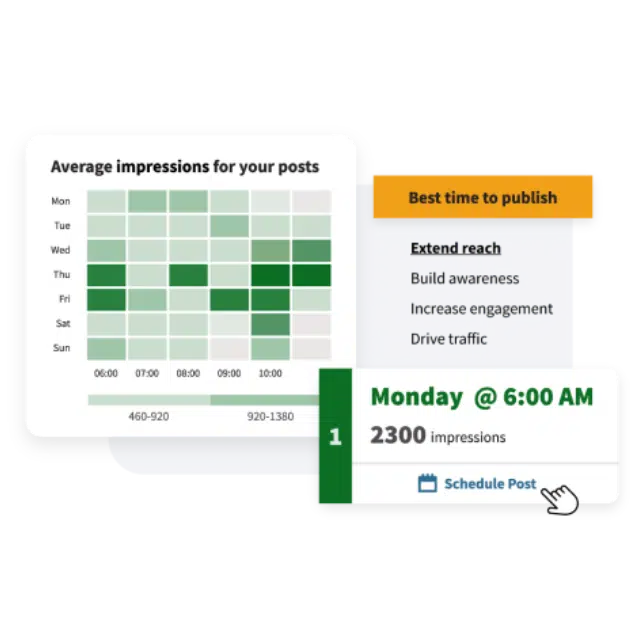With over 2 billion monthly active users, Instagram is one of the biggest social media platforms with a built-in search engine. And these days, users aren’t just scrolling their feeds — they’re actively searching for brands, products, and content using keywords, hashtags, and even the Explore page.
This is where Instagram SEO comes in. By optimizing your content for search, you can increase your visibility, engagement, and followers.
But where do you start, and what actually works in 2025? To find out, we interviewed several social media experts who have mastered the art of Instagram SEO. They shared what to do and not to do to appear in Instagram’s search results. Keep reading on for their tried-and-true tips.
What is Instagram SEO, and why is it important?
Instagram SEO is the practice of tailoring your Instagram content to achieve maximum discovery in search results on the platform. Instagram search results can include relevant content, accounts, audio, hashtags, places, and Reels.
When a user enters keywords related to your business in the Instagram search box, you want your account or content to appear at the top. And following search engine optimization best practices for Instagram can help you achieve this.
To illustrate the importance of social media SEO, Hootsuite ran an experiment comparing optimized and non-optimized Instagram posts. The main takeaway: SEO-optimized posts can earn 30% more engagement.
Here’s a list of the ways Instagram SEO tactics can benefit you:
- Increase discoverability: Optimizing your content for search helps it appear in Instagram search results, Explore feeds, and suggested posts. Moreover, Google indexes Instagram posts, so any SEO tactics you apply can give you a massive opportunity for extra reach.
- Grow your audience organically: More reach means more potential engagement, followers, and customers without paying for ads.
- Win favor with the algorithm: As Instagram continues to improve its search features, SEO-friendly content is more likely to rank higher and be favored by Meta’s algorithms.
- Boost long-term reach: While most feed posts experience ephemeral results, well-optimized content can continue attracting views and engagement anytime users search for it.
- Gain a competitive edge: Creating search-optimized content can help you stand out from and perform better over time against competitors in your niche.
Free Instagram SEO tool
Looking to boost your Instagram SEO strategy? Hootsuite’s free Instagram SEO tool can help you increase your visibility, engagement, and followers on the platform.
Using the tool below, you can create SEO-optimized captions for your Instagram posts that will help get them in front of the right audience.
Here’s how to use it:
- Select the style (aka tone) of your caption. Choose from casual, dry, formal, fun, helpful, inspirational, and other categories.
- Choose the language you’d like your caption to be in. The tool currently supports writing Instagram captions in English, Spanish, Italian, French, and German.
- Add a short description of your post. You can include the post type (Story, Reel, carousel, etc.) and what the post contains. You can use a maximum of 200 words to describe your post.
- Add any relevant keywords that you want included in your caption.
- Finally, click Generate caption to get your SEO-optimized caption! Be sure to check the caption for accuracy and brand voice before posting.
4 Instagram SEO ranking factors
According to Instagram, four SEO ranking factors help determine what and how content is shown in search results:
- Search text: Instagram considers the text users type in the search bar to be the most important factor. Based on the search terms, Instagram looks for relevant usernames, bios, captions, hashtags, and locations.
- User activity: Instagram considers users’ activities on the platform, including accounts followed, hashtag interactions, and posts viewed. Search results will show accounts and hashtags a user has interacted with higher than other results.
- Popularity signals: After prioritizing the above two signals, Instagram will rank results based on their popularity, based on total clicks, likes, shares, and follows.
- Publish date: Instagram tends to show more recent posts in search results.
In this Reel, Instagram chief Adam Mosseri explains how to ensure your content gets recommended on Instagram in 2025.
One more thing: Your content must follow Instagram’s Recommendation Guidelines to appear in search results, and your account can’t violate any Community Guidelines.

In this search, some accounts rank higher because I follow mutual accounts. If you search the same phrase, your results would look different from mine. Give it a try!
How to do Instagram SEO in 3 steps
If you’re new to SEO, here are three easy steps to get started with optimizing your content on Instagram.
1. Understand your target audience
Before you can tailor your content to appear in the right searches, you need to understand your target audience’s mindset.
Some questions to ask yourself or your team:
- What are your customers’ pain points?
- What words do customers naturally use when searching for solutions to problems that your business solves?
- What do customers search before looking for buyable solutions to those problems?
Pro tip: You can use social listening tools such as Hootsuite to discover your audience’s preferences, common questions, and frustrations.

Within Hootsuite, you can generate a word cloud to identify related words to add to captions and hashtags.
2. Conduct keyword and hashtag research
Once you’ve answered the questions in step one, you’ll have some good starting points to kick off your keyword research.
This research aims to narrow down the phrases, words, and relevant hashtags for your business that your audience uses when searching for things related to your business.
Here are some tools that you can use to do keyword research:
- Google Analytics: See which keywords are driving traffic to your website
- Google Trends: Discover trending and rising searches to inspire new content and related keywords to test in your Instagram posts
- Hootsuite Social Listening: Use the word cloud feature to uncover common words used in relation to your brand, industry, or hashtags
- Instagram search bar: Type a word in the search bar to discover suggested tags that you can add as keywords or hashtags

3. Add keywords to your content
After step two, you should have a good list of keywords and phrases to integrate into your content. We suggest grouping them by theme, product, or whatever makes sense for your business so that you have separate groups of keywords to test and rotate through.
You can add keywords to your content in a few ways:
- As titles: For audios and locations
- In captions: Woven naturally into the post copy
- As hashtags: Added to the caption (placement doesn’t matter)
- As alt text: In the text used to describe visuals in your post
Note that currently, only captions are searchable, so you should add any SEO keywords and hashtags in your post caption, not comments.
11 Instagram SEO tips to increase your reach, according to the experts
To get the best insights on what’s working for Instagram SEO in 2025, we interviewed Evelina Milenova, SEO & Growth Manager at Opinion Stage, and Ali Cameron, Disability Advocate & Creator of Seated Perspectives.
1. Think audience-first
When doing keyword research, it may seem simple to guess which search terms your audience is using. However, Cameron strongly warns against this trap:
“Instead of relying on what you would call yourself or your service offerings, think about the words your target audience would use to describe or search for you.”
2. Know your content pillars
To streamline the process of incorporating relevant keywords into your content, Milenova recommends these steps:
- Define your content pillars: Identify the general themes you post about. Example: A wellness coach’s pillars could include fitness, nutrition, and mental health.
- Outline key topics under each pillar: For example, under the fitness pillar, the coach could share workouts for different muscle groups, common mistakes when performing exercises, and tips on building a weekly workout routine.
- Make a keyword list: Write a list of keywords related to your key topics and use them naturally in captions.
Ashley Lemieux posts about motherhood as one of her content pillars and reflects that naturally with many parenting-related keywords in this caption.
3. Test long-form captions
Given users’ short attention spans and scrolling behaviors, writing extended captions on Instagram may seem counterintuitive. However, Cameron explains the potential SEO benefits:
“Captions offer great keyword real estate. Try to find a balance in storytelling and introducing keywords that align with your target audience.”

Source: @seated.perspetives
This carousel features a lengthy caption but balances keywords and storytelling to compel viewers to read the whole thing.
4. Prioritize for engagement
As explained in the ranking factors section above, boosting the popularity of your Instagram account and content can help your SEO, especially through high engagement.
Milenova’s tip to increase your popularity: “Lean into the most promoted formats on the Explore page, such as Reels and carousels (with music added).”
5. Engage consistently with related accounts
Engaging with accounts that already rank for your target keywords helps Instagram understand what niche your account fits into through the user activity ranking signal.
“To appear more often in ‘for you’ and ‘suggested’ results, you need to engage with more accounts. These accounts can include potential customers and related businesses.” shares Milenova
6. Always fill in alt text
Alt text describes your content for users who use accessibility tools like screen readers. Alt text is essential for SEO because it helps Instagram understand what’s in your content and which search queries to place it in.
While alt text may offer another opportunity to improve your SEO, Cameron advises keeping its intended purpose in mind: “Make sure you’re not compromising the true intent of alt text (accessibility) by injecting it with keywords.”
You can add alt text when publishing a post by tapping Advanced Settings > Write Alt Text.

One pro tip from Milenova: “Adding alt text can feel very time-consuming, especially for carousel posts. One thing I do is bulk-upload all images into ChatGPT and ask it to create alt text under 100 characters.”
For more tips, check out our full guide on Instagram alt text.
7. Don’t ignore hashtags
Although Instagram hashtags may not be as vital for reach as they used to be, they can still offer valuable benefits for searchability.
“While you don’t need to stuff your caption with hashtags anymore, you can still use 3-5 that feature commonly searched terms. When using hashtags, remember to use camel case to make them accessible.” shares Cameron
8. Post at the right time
Posting at the right time is crucial for gaining early engagement with your content, which is one of the popularity ranking signals. Knowing the best times to post ensures your content gets a search boost while remaining fresh and relevant.
Hootsuite’s Best Time to Publish feature (found under Analytics) tells you the best times to post on Instagram (and other platforms). The recommendations are based on your account’s past performance and tailored to your audience and social media activity patterns.

The Best Time to Publish tool goes one step further and suggests different times based on four key goals:
- Extend reach
- Build awareness
- Increase engagement
- Drive traffic
This feature allows you to match each piece of content to a specific business goal and optimize your posting schedule for maximum effectiveness.

Find out when your audience is online and optimize your posting schedule for maximum engagement. It’s so easy.
Start free 30-day trial9. Get hyperlocal
If your business has physical stores or operates in specific locations, you should highlight this in your Instagram profile to appear in geographically relevant searches.
You can add a location within the Contact options on your profile (only available for Instagram Business accounts). You can list a country, city, or precise address.

Source: @cocobubbletea.nl
Milenova offers a bonus tip: “Add your location to your handle or profile name, which is more searchable than just adding it in the bio or address field.”
10. Optimize your Instagram profile
Posts aren’t the only place to optimize for SEO on Instagram. You can also tailor your Instagram profile for maximum searchability:
- Instagram bio SEO: Add keywords to your bio that give context about your account, including who you are, what you post about, and what locations you operate in (if applicable).
- Instagram username SEO: If you have a recognizable brand name, you should use that as the base for your username. If there’s room for a relevant keyword in your handle, you can consider adding it.
- Instagram name SEO: According to Instagram, you should use a name related to your content to show up in searches. Instead of your name, you could use words describing your products or niche.

Source: @seated.perspectives
“I include terms such as ‘brand coach’ ‘disabled women’ ‘branding and mindset guide’ on my profile to make it easier for my target audience to find me.” says Cameron
Pro tip: Here are two free tools for SEO optimization: an Instagram bio generator and an Instagram username generator.
11. Consider Meta Verified
Meta Verified is a paid subscription for businesses that includes search optimization on Instagram and Facebook as one of its benefits.

Source: Facebook
Verified users get the coveted blue check mark beside their username and other features like account support, impersonation protection, and enhanced profile features. Businesses must apply and meet eligibility requirements to get verified.
Meta Verified starts from $14.99 USD per month, which could be worthwhile if more visibility in search results leads to more business.
Read our complete guide on how to get verified on Instagram.
3 Instagram SEO mistakes to steer clear of
1. Using non-relevant keywords on your profile
Cameron warns against using overly creative terms to describe your business in your Instagram profile.
“There’s a trend amongst service providers of calling themselves cute names like ‘branding chef’ or ‘messaging magician’, yet that would never be what I would search for to find someone who could help in those areas.”
2. Keyword and hashtag stuffing
Cramming your captions with keywords and hashtags might seem like a good way to rank higher, but it can hurt your reach and engagement.
Instagram’s algorithm favors natural, readable content. So, write captions that incorporate keywords naturally and focus on 3-5 highly relevant keywords that accurately reflect your content and audience.
3. Not posting Reels
Although creating videos can require a lot of effort for small businesses, Milenova says the benefits are worth it — especially for the SEO benefits.
“Reels give you many opportunities to get discovered: they take double-size real estate on the Explore page and offer SEO keyword opportunities with captions and subtitles.”
Instagram SEO FAQs
How do you do SEO on Instagram?
Instagram SEO follows the same best practices as SEO elsewhere on the internet. Do audience research to identify keywords you want to rank for, integrate those keywords into your content, captions, and profile, and follow Instagram’s Recommendation and Community Guidelines.
How do I check my SEO on Instagram?
You can check your SEO on Instagram by searching keywords or hashtags related to your brand and seeing how high your content ranks.
Tip: Search for an account that doesn’t follow you and hasn’t interacted with your content.
What are SEO hashtags?
SEO hashtags are words or phrases optimized for search and discoverability and used within a post caption. Note that you must put hashtags in the caption for the post to be rankable in search results.
What are SEO keywords in an Instagram example?
In the above example, some SEO-friendly keywords would be “viral,” “engagements,” “audience,” and “social,” which would help the post appear to users searching for information about social media marketing and how to go viral.
Use Hootsuite to schedule Instagram posts at the best time, respond to comments, track competitors, and measure performance—all from the same dashboard you use to manage your other social networks. Start your free trial today.







